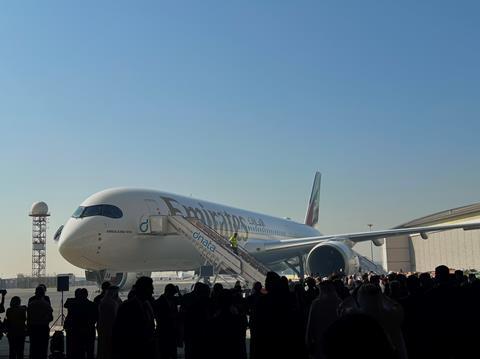Emirates Airline hopes by next summer to be operating both versions of the Airbus A350-900 it has on order, as deliveries of the widebody twin to the Gulf carrier ramp up.
Speaking at an event in Dubai on 27 November to mark the arrival of the first A350 from a 65-unit order, Emirates president Sir Tim Clark said the initial example was configured for “regional” missions of up to 12h.

Seating 312 passengers, the twin-aisle “offers a versatile mix of capacity and range” which “allows new destinations we have not previously considered”, says Clark.
The first aircraft (A6-EXA) will debut on the Dubai-Edinburgh route from 3 January “and we already have eight more cities lined up”, says Clark.
Later deliveries will also include an “ultra-long-range version” capable of flying “16-hour missions” to “almost anywhere in the world” from the carrier’s Dubai base.
However, these A350s will not be the ULR variant of the -900 already flown by Singapore Airlines which feature a modified fuel system allowing nonstop flights of over 20h.
Instead, Emirates will add a crew-rest area and reduce the passenger count to 298 to allow the longer flights.
Clark remains tight-lipped on potential destinations but says the twinjet “gives us great legs to do a lot of cities that we don’t already serve”.
No details of the split between the two versions has been disclosed, however.
Clark says the longer-range model should be delivered in “June or July next year”, although the exact timeline will depend on the airframer.
Philippe Mhun, Airbus executive vice-president for programmes and services, declines to say how many A350s it will hand over to Emirates next year, but says the carrier will account for a “large part” of 2025’s output – somewhere in the region of 25-30%.
For the year to end-October – the most recent period for which figures are available – Airbus had shipped a total of 38 A350s. While that represents a rate of around four per month, production is thought to be running slightly higher, at around five to six aircraft per month – not least that it delivered 64 units last year, or slightly over five monthly.
Conservative calculations would see Emirates receive at least a dozen A350s next year, with the total potentially as high as 20.
That would fit with Emirates’ previously disclosed schedule: announcing its expanded commitment for A350s at the Dubai air show last year, the airline said deliveries would run from August 2024 until early 2028.
Clark says the carrier remains “expansionist” but requires additional capacity to meet its goals. “We are a frustrated entity because we need aeroplanes and we need them now.”
Had Boeing managed to keep to the original timeline for the 777X “we would have had 85 777Xs by now”, says Clark.
Boeing’s latest forecast is for 777X deliveries to start in 2026, although with Emirates third in line to receive the twinjet, its deliveries are likely to be towards the back end of the year at best.

Clark says Emirates will have to “bide its time and [Boeing] have to sort out the situation they are in” before the schedule can be firmed up.
In addition, Clark says he has “no idea” when deliveries of its 35 787s – a mixture of -8s and -10s – are meant to start, “due to the syndrome at Boeing”.
In the meantime, Emirates continues to evaluate the potential for a future A350-1000 order. Clark previously indicated he would not commit to the variant due to the performance and durability of its Trent XWB-97 engines in hot and sandy conditions – issues Rolls-Royce has moved to deal with, outlining a technology insertion plan that will begin to deliver from 2028.
“As soon as they have those issues resolved and can prove that… we are ready to have a conversation,” he says, although any order for the -1000 would be a few years away.
While Emirates has “contractual guarantees” from Rolls-Royce for the XWB-84 engines on the A350-900 Clark does not think these will be activated: “So far we have heard a really good story on the XWB-84.”
Configured with three cabins, Emirates A350-900s accommodate 32 passengers in business class in a 1-2-1 layout, 21-28 in premium economy (2-3-2) and up to 259 in economy (3-3-3).
“Our updated interiors and seating configurations will help us deliver a more elevated and comfortable experience to travelers across every cabin class,” states Clark.
“The moment you step on board you’ll notice the sense of space and light and many thoughtful features and luxury touches.”
Seats have been improved for all passengers, and the aircraft is equipped with the latest generation of the carrier’s ICE in-flight entertainment system.
Mhun flew aboard the A350 on its ferry flight from Dubai following delivery on 25 November. “You can feel the Emirates touch,” he says, and praises the “huge amount of co-operation” between the pair to bring it to life.
































